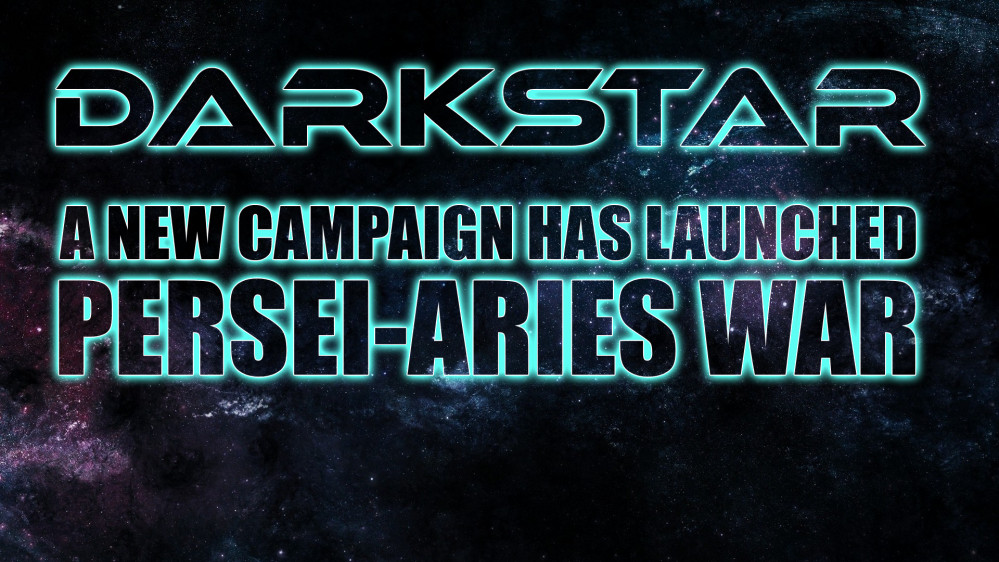
Persei-Aries War Resumes
Third Hercules War Officially Underway!
FROM: UNITED NATIONS REGIONAL COLONIAL CENTER
02:30 SOL GMT, 22 OCTOBER 2520
BREAKAUTH: 181072.18J
CLEARANCE: SECRET (NATIONAL)
**UNITED NATIONS COMMUNIQUE**
This advisory communique is hereby issued from the United Nations Communications and Liaisons Administration (UNCLA), Hercules Strategic Command Sector (SCS), to the offices of all colonial and regional governors, senior ambassadors, and national-level adjutants (level NG-21 and above) as previously specified as CLEARANCE level contacts by the secretaries and ministers listed as AUTHORIZED for such communication materials, as recorded on file by this office.
A shipping and superluminal courier advisory is now in effect for star systems within the Hercules SCS, ranging in radial Sol distance of 7-20 parsecs (22.82 to 65.2 light years). BE ADVISED A STATE OF CRISIS now exists for planetary systems, colonies, automated shipping lanes, and interstellar medium for the space prescribed and enclosed by parameters outlined above.
Eight days ago, an incident occurred in the outer protoplanetary debris disc of the Zeta Hercules star system involving naval and aerospace units of the Navies of the HOLY RUSSIAN EMPIRE, the EMPIRE OF JAPAN, and the CONSORTIUM OF INTERNATIONAL COMMERCE AND DEVELOPMENT (Corporate Consortium). Reports of this incident, which took place some 7.4 parsecs from this office, is only now being reported, and details are far from complete. At this hour, all this office can confirm with certainty is that heavy weapons fire was exchanged between these forces, resulting in significant loss of life and damage to property.
Negotiations between the parties involved are presently underway here at the Almacor Colonial Offices for the United Nations, Hercules SCS Regional Branch, at Redemption Colony (99 Hercules). Updates will be passed to authorized national-level offices as events develop.
In the meantime, the United Nations urges and advises with all gravity that military commanders under each nation’s respective naval commands be contacted with all possible speed. The value of caution and forbearance at this critical juncture cannot be overstated if a general STATE OF WAR is to be avoided.
>>>>
Such was the communique sent by automated FTL drone to all the governments and military command centers in the Hercules Strategic Command Sector, dated 22 October 2520. Of course, even with 12-magnitude Darkstar waves, some colonies wouldn’t get this message for 10-12 days. Such is the travel times across these distances even at x1000c. In any event, by then it was too late. News of the initial battle had already spread, and decisions had already been made. The THIRD HERCULES WAR was on.
The .pdf attached to this project thread in a previous post already outlines the background and recent history of this region, describing the steadily building tension between the United States, the Holy Russian Empire, and the Indian Republic on one side, and the United Kingdom, Japan, the Corporate Consortium on the other. The powder keg was set. Saturday’s battle between myself, @gladesrunner, and @rasmus is the spark that blew it up.
In short, this is the beginning of a new Darkstar campaign, which we hope you will enjoy looking through, perhaps following, or even joining in!
Engagement 01: Meeting Skirmish in Outer Ice Belt, Kyokko Bijin (Zeta Hercules), 14 October 2520
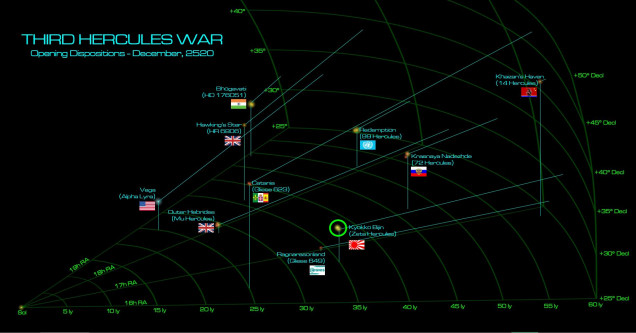 The green circle marks the location of our first battle. A United Nations envoy ship was on its way from Redemption back to Sol. Along the way, it stopped just outside the Zeta Hercules system in order to download new navigation data from the network of satellites, drones, and beacons that every colonized star system has deployed for this purpose. All these star systems are moving in relation to each other, after all, and for safe and efficient Darkstar waves, incredibly-detailed navigation data must be constantly updated into each ship’s computers. Thus, most of the safer, more mundane civilian and commercial shipping lanes pass through as many star systems as possible.
The green circle marks the location of our first battle. A United Nations envoy ship was on its way from Redemption back to Sol. Along the way, it stopped just outside the Zeta Hercules system in order to download new navigation data from the network of satellites, drones, and beacons that every colonized star system has deployed for this purpose. All these star systems are moving in relation to each other, after all, and for safe and efficient Darkstar waves, incredibly-detailed navigation data must be constantly updated into each ship’s computers. Thus, most of the safer, more mundane civilian and commercial shipping lanes pass through as many star systems as possible. 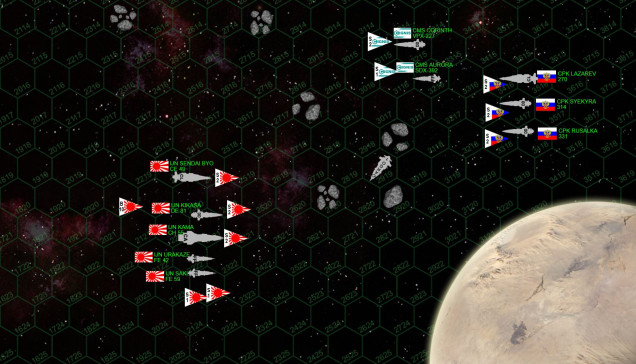 Ironically, it was this need for navigational safety that got the SS Serendipity into navigational trouble, striking an asteroid in the outer ice belt of the Zeta Hercules star system, taking enough damage that she had to eject her starboard reactors to avoid a catastrophic overload. Now adrift in the weak gravity of this ice belt dwarf planet (1800 kilometers across, about three-quarters the diameter of Pluto), she dropped universal rescue beacons (URBs), asking for help. Well, help arrived all right. Mostly from the Japanese (Zeta Hercules is their system, after all), but also from a roving cruiser squadron of the Holy Russian Empire and a destroyer-blockade runner element of the militarized “maritime security consultant branch” of the Cignis Corporation. As the three task forces close, the Japanese continue to warn off the Russians and Corporates, warning them that Kyokko Bijin is Japanese sovereign territory. A flight of Japanese B7N “Tenrai” (Heavenly Thunder) bombers joins the cruiser force from a nearby system patrol station. Meanwhile, the Russians and Corporates counter that the URBs deployed by SS Serendipty, a UN-flagged vessel, makes this an international call for help. What both sides really want, of course, is to take credit for rescuing the UN ship, thus lending legitimacy for their ongoing claims in the escalating Hercules crisis. Strike that, what they REALLY want is a fight. Both sides feel they can sweep in quickly, smash up a few enemy ships, and streak back out again, claiming an early lead in the new Third Hercules War.
Ironically, it was this need for navigational safety that got the SS Serendipity into navigational trouble, striking an asteroid in the outer ice belt of the Zeta Hercules star system, taking enough damage that she had to eject her starboard reactors to avoid a catastrophic overload. Now adrift in the weak gravity of this ice belt dwarf planet (1800 kilometers across, about three-quarters the diameter of Pluto), she dropped universal rescue beacons (URBs), asking for help. Well, help arrived all right. Mostly from the Japanese (Zeta Hercules is their system, after all), but also from a roving cruiser squadron of the Holy Russian Empire and a destroyer-blockade runner element of the militarized “maritime security consultant branch” of the Cignis Corporation. As the three task forces close, the Japanese continue to warn off the Russians and Corporates, warning them that Kyokko Bijin is Japanese sovereign territory. A flight of Japanese B7N “Tenrai” (Heavenly Thunder) bombers joins the cruiser force from a nearby system patrol station. Meanwhile, the Russians and Corporates counter that the URBs deployed by SS Serendipty, a UN-flagged vessel, makes this an international call for help. What both sides really want, of course, is to take credit for rescuing the UN ship, thus lending legitimacy for their ongoing claims in the escalating Hercules crisis. Strike that, what they REALLY want is a fight. Both sides feel they can sweep in quickly, smash up a few enemy ships, and streak back out again, claiming an early lead in the new Third Hercules War.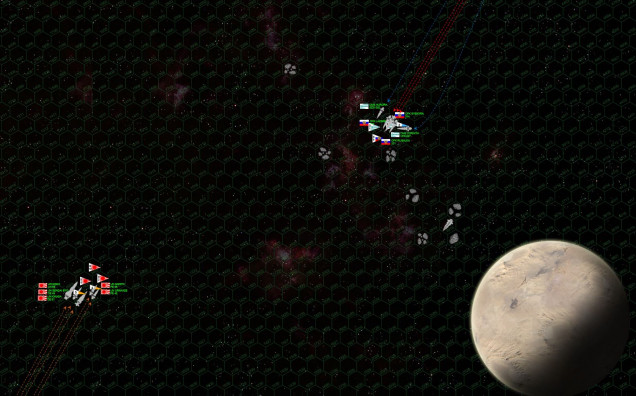 Both sides make their approach. The Russians set the pace for their side, barreling into the combat area at the very high speed of 36 kilometers per second. The Japanese set the more reserved speed of 24 kps, anxious as always to keep the range long for their cruisers mounting hyper-accurate and long-ranged guns. Russians, conversely, like to get close, firing blistering jets of plasma at near point-blank range. Note how the Russian commander, Captain Piotr Fedorovich Myshaga, carefully keeps an asteroid field between his approach vector and the Japanese. Thus the Japanese can only fire on the Cignis destroyer CMS Corinth, and her advanced ECM suites and gravitic shielding protect from most of that. True, the Russians can’t fire back right now, but more importantly ... they’re over 2,000 kilometers closer to the Japanese now, and all without taking a whiff of fire.
Both sides make their approach. The Russians set the pace for their side, barreling into the combat area at the very high speed of 36 kilometers per second. The Japanese set the more reserved speed of 24 kps, anxious as always to keep the range long for their cruisers mounting hyper-accurate and long-ranged guns. Russians, conversely, like to get close, firing blistering jets of plasma at near point-blank range. Note how the Russian commander, Captain Piotr Fedorovich Myshaga, carefully keeps an asteroid field between his approach vector and the Japanese. Thus the Japanese can only fire on the Cignis destroyer CMS Corinth, and her advanced ECM suites and gravitic shielding protect from most of that. True, the Russians can’t fire back right now, but more importantly ... they’re over 2,000 kilometers closer to the Japanese now, and all without taking a whiff of fire. 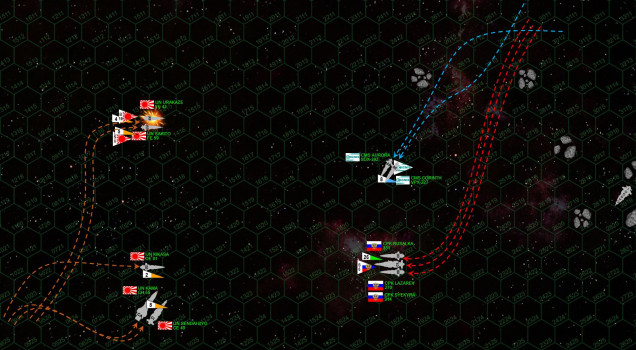 Weaving through the asteroid fields trailing behind the dwarf planet’s orbital path, the Russians make a sharp hook to starboard and again cut straight toward the Japanese. Again, note Myshaga’s positioning. By placing himself between the Japanese and the dwarf planet, he forces the Japanese to turn dangerously toward the planet to engage him. Any Russian fire now coming at the Japanese is that much more dangerous, as crippled or disabled ships run the risk of collision with the planetoid. Also, Myshaga has consulted with his corporate ally, Vice-President Ike Karus, and they decided to make their initial attack with torpedoes rather than broadside gunnery. Thus, the Russians point their port and starboard bow arcs toward the Japanese, rather than their beams. Yet even at this distance, the guns of the Japanese cruisers are dangerous, and heavy lasers, EPCs, and syglex emitters (x-ray “lasers” focused through intense gravitic lensing) open jagged slashes in Russian and Corporate ships. This is especially true since ALL guns of the Japanese strike frigates Urakaze and Sakita are mounted forward, as well as most of the guns of the heavy cruiser Kama (her guns arranged in a “Pacific” configuration, in three triple turrets with two turrets forward and only one aft). The light cruiser Admiral Lazarev takes the worst of it, how bow torn clean open and her forward shields gone. Yet the Russians and especially the Cignis ships score heavy blows on the little Japanese strike frigate Urakaze, the precise lasers of the Corinth drilling deep into the bow and setting off the magazine and hitting the bridge. Already one ship is down, the IJN Urakaze the first official “casualty” of the Third Hercules War.
Weaving through the asteroid fields trailing behind the dwarf planet’s orbital path, the Russians make a sharp hook to starboard and again cut straight toward the Japanese. Again, note Myshaga’s positioning. By placing himself between the Japanese and the dwarf planet, he forces the Japanese to turn dangerously toward the planet to engage him. Any Russian fire now coming at the Japanese is that much more dangerous, as crippled or disabled ships run the risk of collision with the planetoid. Also, Myshaga has consulted with his corporate ally, Vice-President Ike Karus, and they decided to make their initial attack with torpedoes rather than broadside gunnery. Thus, the Russians point their port and starboard bow arcs toward the Japanese, rather than their beams. Yet even at this distance, the guns of the Japanese cruisers are dangerous, and heavy lasers, EPCs, and syglex emitters (x-ray “lasers” focused through intense gravitic lensing) open jagged slashes in Russian and Corporate ships. This is especially true since ALL guns of the Japanese strike frigates Urakaze and Sakita are mounted forward, as well as most of the guns of the heavy cruiser Kama (her guns arranged in a “Pacific” configuration, in three triple turrets with two turrets forward and only one aft). The light cruiser Admiral Lazarev takes the worst of it, how bow torn clean open and her forward shields gone. Yet the Russians and especially the Cignis ships score heavy blows on the little Japanese strike frigate Urakaze, the precise lasers of the Corinth drilling deep into the bow and setting off the magazine and hitting the bridge. Already one ship is down, the IJN Urakaze the first official “casualty” of the Third Hercules War. 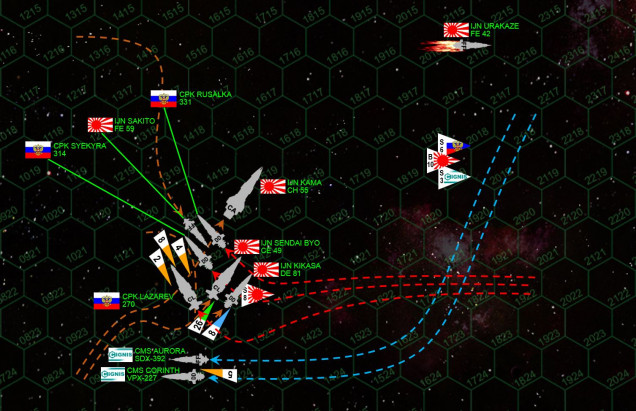 The Kama lunges for the Russians, hoping to cross their T with a devastating broadside. Myshaga sees the move and veers to port, then cutting hard to starboard. His destroyers CPK (Svyatoy Russki Korabl, Holy Russian Ship) Syekyra and Rusalka execute the maneuver perfectly, cutting their starboard broadsides behind the huge heavy cruiser Kama. Myshaga’s flagship CPK Admiral Lazarev moves to follow suit (with no forward shields, he knows his ship is about to be crippled, but resolves to take the larger IJN Kama with him), but has to veer further behind the Kama to avoid a collision with the oncoming strike frigate IJN Sakita. The light cruiser IJN Sendai Byo cuts in behind the Russian destroyers, escorted by the veteran destroyer IJN Kikasa, only to have the destroyer Corinth and blockade runner Aurora cut in behind THEM ... only to have the Japanese bombers launch a torpedo spread behind THEM. One way or another, this “skirmish” is about to become a knife fight of gruesome proportions.
The Kama lunges for the Russians, hoping to cross their T with a devastating broadside. Myshaga sees the move and veers to port, then cutting hard to starboard. His destroyers CPK (Svyatoy Russki Korabl, Holy Russian Ship) Syekyra and Rusalka execute the maneuver perfectly, cutting their starboard broadsides behind the huge heavy cruiser Kama. Myshaga’s flagship CPK Admiral Lazarev moves to follow suit (with no forward shields, he knows his ship is about to be crippled, but resolves to take the larger IJN Kama with him), but has to veer further behind the Kama to avoid a collision with the oncoming strike frigate IJN Sakita. The light cruiser IJN Sendai Byo cuts in behind the Russian destroyers, escorted by the veteran destroyer IJN Kikasa, only to have the destroyer Corinth and blockade runner Aurora cut in behind THEM ... only to have the Japanese bombers launch a torpedo spread behind THEM. One way or another, this “skirmish” is about to become a knife fight of gruesome proportions.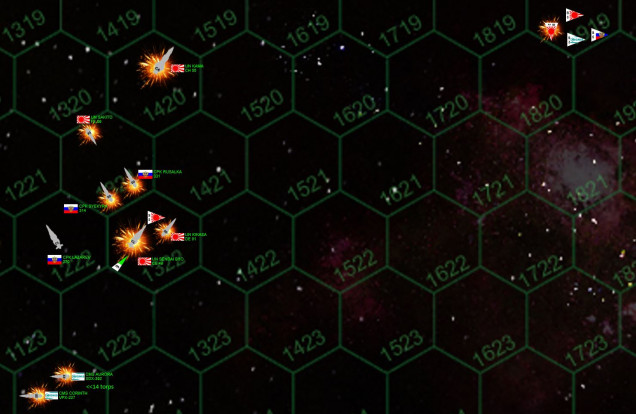 Okay, to get a better view on what’s actually happening here, I have blown up the hexes through which all these ships are all moving, and in what directions, at the crucial moment. Please remember these hexes are 180 kilometers across, a turn is one minute of time, and one hex of movement is thus 3 kilometers per second. The ships themselves are still massively oversized, usually 1 or 1.5 kilometers long at most. SO ... what happens here? First, the Japanese spread of Ki-45 “Toryu” (Dragon Slayer) torpedoes almost all are shot down. But three hit the unshielded bow of the Lazarev. And these are “Class V” Ki-45s, some of the deadliest torpedoes in Known Space. All three hit internal compartments (all the forward armor is already gone) ... but amazingly, the Lazarev’s bridge remains unstruck ... and the ship retains power. Casualties are heavy, however, and Myshaga is compelled to break off the action ... once he’s released his own withering broadside into the stern of the Kama. At this range ... Russian plasma projectors are just damned terrifying. The stern of the 150,000 ton Kama is simply melted off. Even as the Lazarev reels away, half her crew now killed, wounded, fighting fires, or trying to shore up bulkheads against chain-reaction decompressions, the forward guns of the Syekyra fire into the onrushing strike frigate Sakita (her aft guns firing into the Sendai Byo). The Satika is crippled by the Syekyra’s 40-kg plasma projectors, herself crippled an instant later when the Kama fires back with her huge aft batteries of 18-teravolt EPCs (electron particle cannons). As the Syekyra is left spiraling out of control through space, the Rusalka’s forward guns fire into the Kama, finally inflicting enough damage to cripple the massive Japanese ship. Rusalka’s aft guns fire into the Sendai, even as the Sendai and the escorting Kikasa fires its forward guns into the Rusalka and cripples her as well. Russian P-500 “Plamya” (Flame) Class III torpedoes strike into the hull of the Sendai Byo ... 17 were shot down but 9 hit the shields, three into the hull. Sendai’s portside engine is blown completely apart, opening her up to a hail of laser and syglex fire from the Corinth. Just that fast, the Sendai goes dark as well. The rest of the Corinth’s guns, together with the Aurora, fire into the Kikasa. The Kikasa hits the Aurora through the bridge, even as the Corinth (badly damaged) finally crippled Kikasa as well. Finally, the torpedoes fired from the Japanese bombers slam into the stern of the Corinth, which is likewise crippled. Sixty seconds, eight ships. Welcome to the Third Hercules War.
Okay, to get a better view on what’s actually happening here, I have blown up the hexes through which all these ships are all moving, and in what directions, at the crucial moment. Please remember these hexes are 180 kilometers across, a turn is one minute of time, and one hex of movement is thus 3 kilometers per second. The ships themselves are still massively oversized, usually 1 or 1.5 kilometers long at most. SO ... what happens here? First, the Japanese spread of Ki-45 “Toryu” (Dragon Slayer) torpedoes almost all are shot down. But three hit the unshielded bow of the Lazarev. And these are “Class V” Ki-45s, some of the deadliest torpedoes in Known Space. All three hit internal compartments (all the forward armor is already gone) ... but amazingly, the Lazarev’s bridge remains unstruck ... and the ship retains power. Casualties are heavy, however, and Myshaga is compelled to break off the action ... once he’s released his own withering broadside into the stern of the Kama. At this range ... Russian plasma projectors are just damned terrifying. The stern of the 150,000 ton Kama is simply melted off. Even as the Lazarev reels away, half her crew now killed, wounded, fighting fires, or trying to shore up bulkheads against chain-reaction decompressions, the forward guns of the Syekyra fire into the onrushing strike frigate Sakita (her aft guns firing into the Sendai Byo). The Satika is crippled by the Syekyra’s 40-kg plasma projectors, herself crippled an instant later when the Kama fires back with her huge aft batteries of 18-teravolt EPCs (electron particle cannons). As the Syekyra is left spiraling out of control through space, the Rusalka’s forward guns fire into the Kama, finally inflicting enough damage to cripple the massive Japanese ship. Rusalka’s aft guns fire into the Sendai, even as the Sendai and the escorting Kikasa fires its forward guns into the Rusalka and cripples her as well. Russian P-500 “Plamya” (Flame) Class III torpedoes strike into the hull of the Sendai Byo ... 17 were shot down but 9 hit the shields, three into the hull. Sendai’s portside engine is blown completely apart, opening her up to a hail of laser and syglex fire from the Corinth. Just that fast, the Sendai goes dark as well. The rest of the Corinth’s guns, together with the Aurora, fire into the Kikasa. The Kikasa hits the Aurora through the bridge, even as the Corinth (badly damaged) finally crippled Kikasa as well. Finally, the torpedoes fired from the Japanese bombers slam into the stern of the Corinth, which is likewise crippled. Sixty seconds, eight ships. Welcome to the Third Hercules War.  Here are the warship record sheets for the Japanese cruisers, the Kama and the Sendai Byo. In all, only 8 Japanese bombers remain (two were shot down by Russian and Cignis scouts), and the Russian flagship Admiral Lazarev, although she’s been forced to break off the action. But since she still has power, she counts as “operational” and so the Japanese only get half points for her in this raid. The score is 339 to 291, a 16% victory to the Russians and Corporates. Needless to say, no one’s going to be continuing hostilities now, everyone is full-bore into rescue and recovery efforts. But when news of this incident spreads, the war will officially be on.
Here are the warship record sheets for the Japanese cruisers, the Kama and the Sendai Byo. In all, only 8 Japanese bombers remain (two were shot down by Russian and Cignis scouts), and the Russian flagship Admiral Lazarev, although she’s been forced to break off the action. But since she still has power, she counts as “operational” and so the Japanese only get half points for her in this raid. The score is 339 to 291, a 16% victory to the Russians and Corporates. Needless to say, no one’s going to be continuing hostilities now, everyone is full-bore into rescue and recovery efforts. But when news of this incident spreads, the war will officially be on. 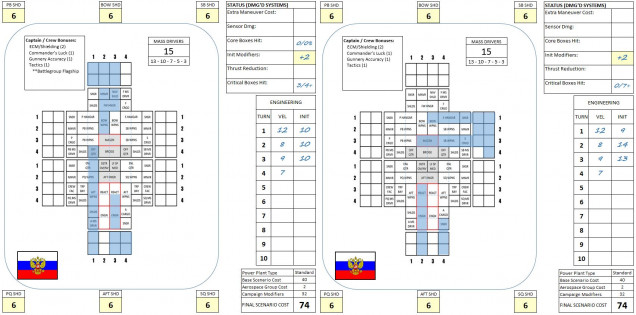 The warship record sheets of the Russian destroyers Syekyra (left) and Rusalka (right). The Americans will be “outraged” at this Japanese aggression, the British will maintain that the Americans are using this pretext to lean into the Hercules Rim from their Vega colony in the neighboring Lyra constellation. As the British and Japanese close ranks, the Americans will cry foul at the continuing Anglo-Japanese shipping and trade monopolies in the Hercules Rim, thus cementing their alliance with the nervous Russians and Consortium. The Americans will also enlist the aid of the Indian Republic, having promised them VERY generous shipping rights through Vega back to earth from the Indian colony at Bhogavati (HD 176051) in return for support against the British at Hawking’s Star and the Outer Herbrides.
The warship record sheets of the Russian destroyers Syekyra (left) and Rusalka (right). The Americans will be “outraged” at this Japanese aggression, the British will maintain that the Americans are using this pretext to lean into the Hercules Rim from their Vega colony in the neighboring Lyra constellation. As the British and Japanese close ranks, the Americans will cry foul at the continuing Anglo-Japanese shipping and trade monopolies in the Hercules Rim, thus cementing their alliance with the nervous Russians and Consortium. The Americans will also enlist the aid of the Indian Republic, having promised them VERY generous shipping rights through Vega back to earth from the Indian colony at Bhogavati (HD 176051) in return for support against the British at Hawking’s Star and the Outer Herbrides. 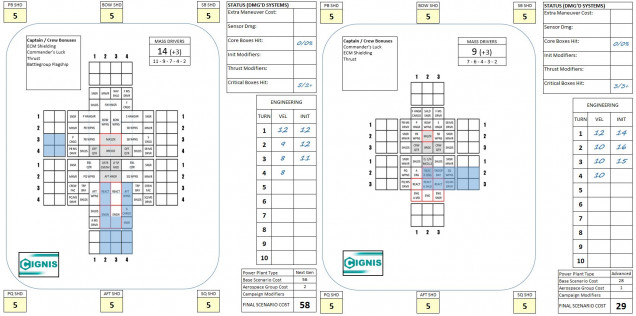 The Cignis destroyer Corinth and blockade runner (fast frigate) Aurora. In general, the Consortium likes to stay out of wars, but when they’re involved in one, they tend to pick the weaker side, if not from a military standpoint, at least a commercial one. The last thing they want is sectors of space dominated by monolithic national monopolies, like the one the British and Japanese are setting up along the Hercules Rim. The more “open” they can keep the shipping lanes and colonial development zones, the more free they are to do business and the happier their shareholders are.
The Cignis destroyer Corinth and blockade runner (fast frigate) Aurora. In general, the Consortium likes to stay out of wars, but when they’re involved in one, they tend to pick the weaker side, if not from a military standpoint, at least a commercial one. The last thing they want is sectors of space dominated by monolithic national monopolies, like the one the British and Japanese are setting up along the Hercules Rim. The more “open” they can keep the shipping lanes and colonial development zones, the more free they are to do business and the happier their shareholders are. 




























![TerrainFest 2024 Begins! Build Terrain With OnTableTop & Win A £300 Prize! [Extended!]](https://images.beastsofwar.com/2024/10/TerrainFEST-2024-Social-Media-Post-Square-225-127.jpg)












































One heck of a game – I enjoyed it a lot
Indeed @rasmus – this one got “impolite” … very quickly. I also have your Ship commander names, I will be adding to the records today or tomorrow. I will try to build some kind of master book for all out campaign records, including our “campaign sheets” – and share with the group off Google Docs.
Heck, @oriskany you had me find the rulebook so I could do the upgrades – my fleet now cost 22 points more on the table 🙂
Epic, @rasmus – I have your updates and will plug them into the records. 😀
Very nice! I like the fluff intro and outro bits. I can see this very quickly blowing up into another foolish war. As always, love the realistic lethality of a “close up” Darkstar game.
Thanks, @muakhah – Yeah, Darkstar has always been “aimed” at “foolish” wars, hence the whole neo-Victorian vibe. The Americans with their Theodore Roosevelt “Great White Fleet” posture, the British with their Victorian plutocracy, the Indians MAKING DAMNED SURE they won’t be bending the knee for anyone this time, the Prussians making sure they won’t be hemmed in by geography … and so on. The tradeoff is that the wars are usually small. They’re fought for colonial reasons, commercial development and exploitation … so as soon as the war becomes more expensive than the nascent colonies they’re being fought over, the… Read more »
It was a blast to play. Though I wasn’t expecting EVERYONE to be crippled in one round. I enjoyed playing my fast Corporates as opposed to my hard hitting English.
Hey, not EVERYONE was crippled. 😀 CPK Admiral Lazarev held it together long enough for the Russians and Consortium to technically “win” the battle.